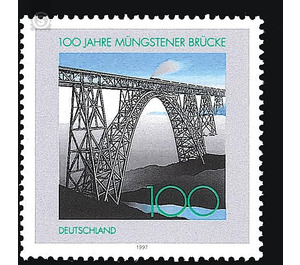Bridges: 100 years of the Müngsten Bridge - Germany / Federal Republic of Germany 1997 - 100 Pfennig
| Country | Germany / Federal Republic of Germany |
| Issue Date | 1997 |
| Face Value | 100.00 |
| Color | grey blue |
| Perforation | K 13 3/4 |
| Printing Type | Multicolor offset printing |
| Stamp Type | Postage stamp |
| Item Type | Stamp |
| Chronological Issue Number | 1804 |
| Chronological Chapter | GER-BRD |
| SID | 879351 |
| In 75 Wishlists | |
On 15 July 1997, the bridge over the Wupper near Müngsten near Wuppertal, Germany's highest railway bridge, becomes 100 years old. The economic growth and interdependence of the Bergisch industrial cities of Solingen and Remscheid had reached a considerable magnitude at the end of the 19th century. The prerequisite for continuous further development was a direct rail link between Düsseldorf and the Rhine ports of these cities, which are within sight (8 km as the crow flies). For a long time, the aspiring cities of Solingen and Remscheid had demanded the traffic-technical solution through a bridge structure because of their mutual relations and in the interest of their economy, because the largest natural obstacle was the wide, deeply cut valley of the Wupper near the town of Müngsten. Technical difficulties and the high costs were initially opposed to the realization. After Remscheid and Solingen had committed to take over the land acquisition costs, approved the Prussian state parliament in 1890 the necessary funds. An extraordinary, pioneering technical achievement could begin. Some numbers may illustrate the uniqueness of the Müngstener bridge: total length 500 m, height above the water level of the Wupper 107 m, span of the bridge arch 170 m, weight of the iron construction 5,000 t. Even though the significant shift in traffic on the road means that the bridge no longer has the practical significance of its construction at the time of its construction, it still represents a monumentally impressive building and a first-rate technical monument. (Text: Stadt Remscheid, German Tool Museum / Historical Center)


